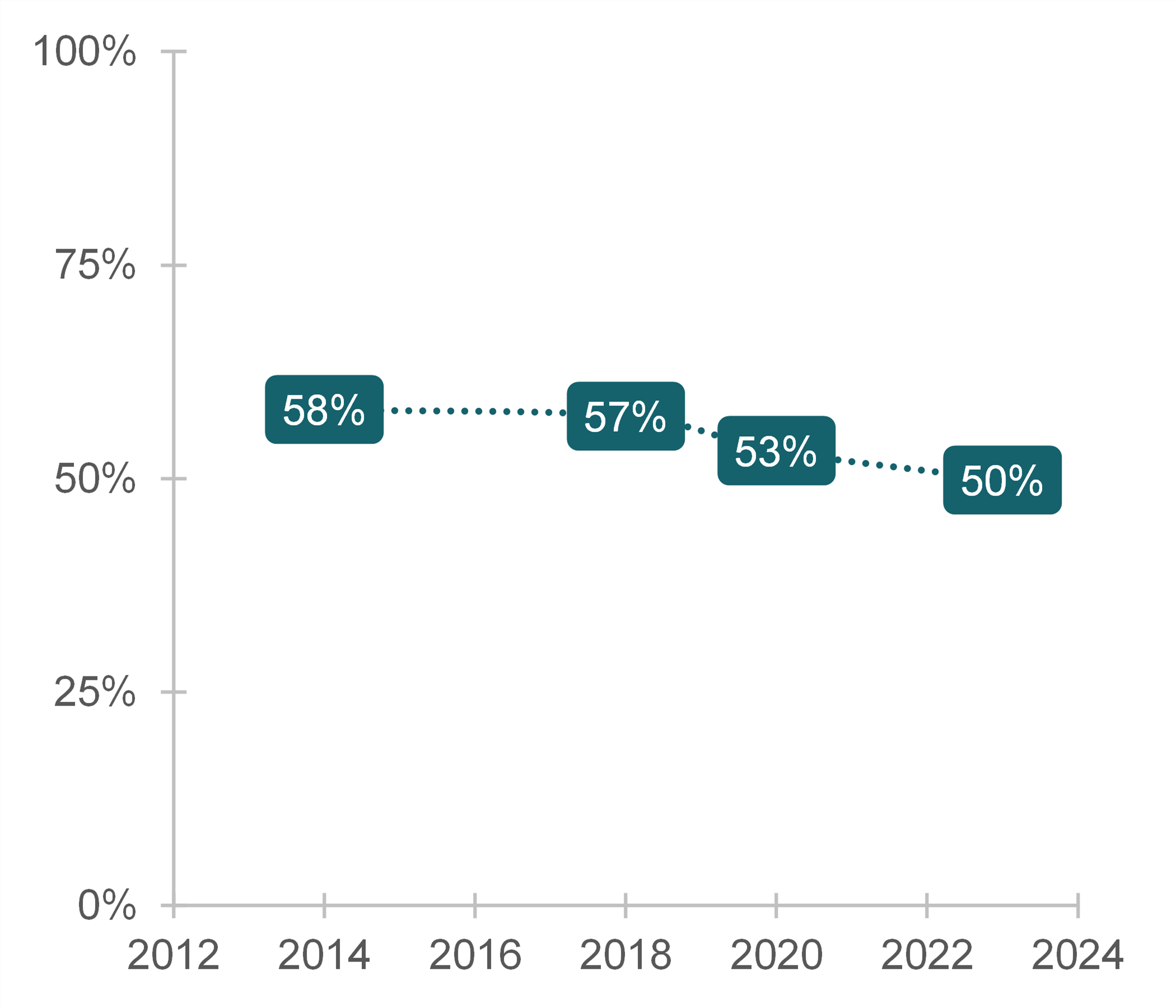Prevalence of Grandparenthood in the U.S., 2022
Family Profile No. 21, 2024
Author: Krista K. Westrick-Payne
In 2022, approximately 60.5 million adults aged 50 and older were grandparents, according to the Survey of Income and Program Participation (SIPP, 2023). The SIPP is a nationally representative household-based survey and is designed to provide comprehensive family and social information on individuals and families. The SIPP gathers information on all individuals who live in a surveyed household and directly asks respondents if they are a grandparent. For these reasons, SIPP is one of the few surveys that identifies non-resident grandparents. In this profile, we identify the prevalence of grandparenthood among adults aged 50 and older and examine their demographic characteristics, including race/ethnicity, educational attainment, and current relationship status. This profile is an update of Stykes, Manning, & Brown, 2014, Wu, 2018, and Westrick-Payne (2023). It is also the fourth in our series on grandparents in the U.S.
- The share of older adults who report having a grandchild has declined in recent years from 58% of those aged 50 and older in 2014 to 50% in 2023.
Figure 1. Trend in Grandparenthood in the U.S., 2014, 2018, 2020, & 2023

Race/Ethnicity and Grandparenthood
- The share of adults aged 50 and older who reported being a grandparent has dropped since 2014 across racial and ethnic groups considered here. The biggest change was among non-Hispanic Asians who dropped by over one quarter.
- Among adults aged 50 and older, an equal percentage of Black and Hispanic older adults were grandparents (52%). They also had the largest share compared to those of other racial/ethnic backgrounds in 2023.
- Half (50%) of White respondents aged 50 and older were also grandparents.
- Adults of Asian ethnicity had the smallest share reporting to be a grandparent—only slightly more than one-third (36%) said they had a grandchild.
Figure 2. Grandparenthood by Race/Ethnicity, 2014 & 2023

Educational Attainment and Grandparenthood
- The share of adults aged 50 and older who reported being a grandparent also dropped since 2014 across educational attainment groups considered here.
- The prevalence of grandparenthood decreased as educational attainment increased.
- Among those aged 50 or older in 2023 without a high school diploma/GED, approaching two-thirds (65%) were grandparents.
- Fifty-nine percent of those with a high school diploma and 51% of those with some college education were grandparents in 2023.
- Being a grandparent was least common among older adults who had at least a bachelor’s degree (39%).
Relationship Status and Grandparenthood
- The prevalence of grandparenthood was lower in 2022 than in 2014 among all grandparents except those cohabiting – increasingly slightly from 46% to 47%.
- Being a grandparent was most common among widowed adults, at 70%. This is not unexpected because the widowed are more often older.
- Similar shares of married and divorced/separated adults were grandparents (53% and 51%, respectively).
- Only sixteen percent (16%) of never-married older adults reported being a grandparent in 2023.
Figure 3. Grandparenthood by Educational Attainment, 2014 & 2023

Figure 4. Grandparenthood by Relationship Status, 2014 & 2023

Data Source:
U.S. Census Bureau, Survey of Income and Program Participation 2014, Wave 1, 2018, 2021, & 2023. https://www.census.gov/programs-surveys/sipp.html
References:
Stykes, B., Manning, W. D., & Brown, S. L. (2014). Grandparenthood in the U.S.: Prevalence of grandparenthood among adults aged 50+. Family Profiles, FP-14-14. Bowling Green, OH: National Center for Family & Marriage Research. https://www.bgsu.edu/content/dam/BGSU/college-of-arts-and-sciences/NCFMR/documents/FP/FP-14-14-grandparent-50-plus.pdf
Wu, H. (2018). Prevalence of grandparenthood in the U.S. Family Profiles, FP-18-03. Bowling Green, OH: National Center for Family & Marriage Research. https://doi.org/10.25035/ncfmr/fp-18-03
Westrick-Payne, K. K. (2023). Prevalence of grandparenthood in the U.S., 2021. Family Profile, FP-23-01. Bowling Green, OH: National Center for Family & Marriage Research. https://doi.org/10.25035/ncfmr/fp-23-01
Suggested Citation:
Westrick-Payne, K. K. (2023). Prevalence of grandparenthood in the U.S., 2021. Family Profile, FP-24-21. Bowling Green, OH: National Center for Family & Marriage Research. https://doi.org/10.25035/ncfmr/fp-24-21
This project is supported with assistance from Bowling Green State University. From 2007 to 2013, support was also provided by the U.S. Department of Health and Human Services, Office of the Assistant Secretary for Planning and Evaluation. The opinions and conclusions expressed herein are solely those of the author(s) and should not be construed as representing the opinions or policy of any agency of the state or federal government.
Updated: 11/26/2024 10:53AM

